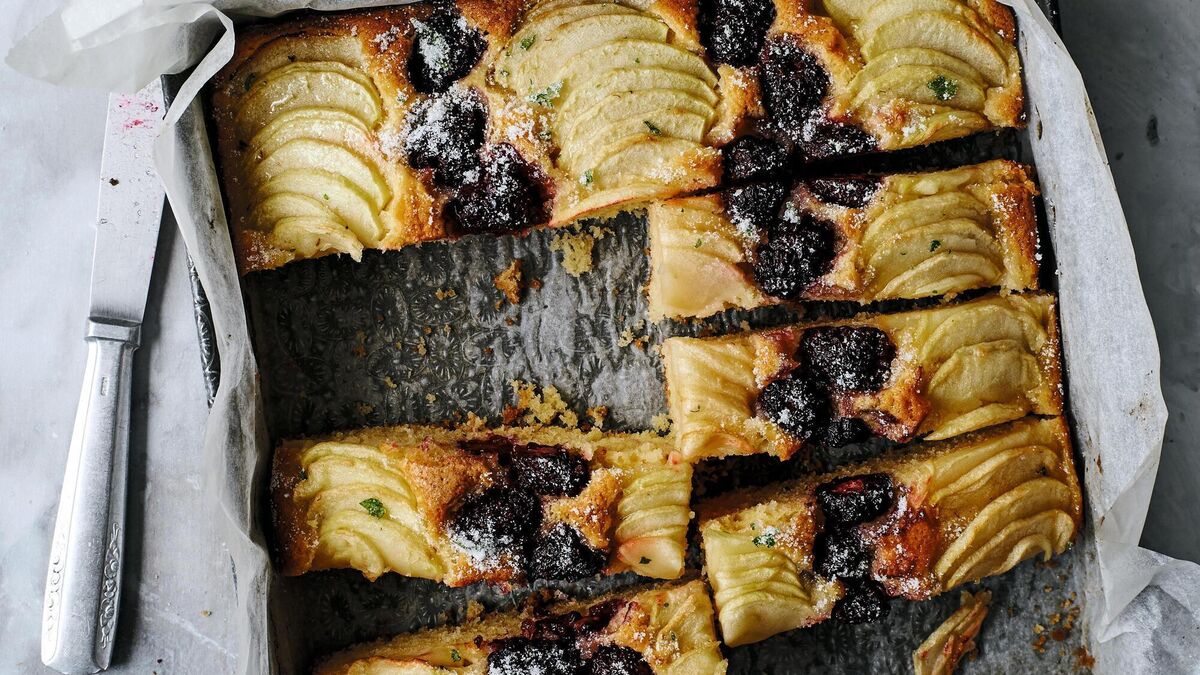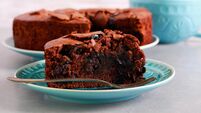Darina Allen: Try your seasonal apples in these sweet autumn bakes

Get some use out of those autumn apples!
Apples, apples everywhere, and what to do…?
I love homegrown apples, we grow many different varieties. It’s kind of odd but I scarcely eat an apple all year, except when our own apples are ripe in the orchard.
It’s not a higher moral ground thing, just that I don’t seem to feel like it and somehow, I have a gnawing unease about possible chemical residues in non-organic apples.
We grow many varieties of both dessert and cooking apples, particularly heirloom varieties that are rarely if ever found in the shops.
They ripen gradually over a long season from the deliciously mottled Beauty of Bath and Irish Peach, (yes, it’s an apple) that ripens in late July to early August to varieties like Honey Crisp and Bramley’s Seedling that matures slowly.
But now, just like many of our neighbours and friends, we have a glut of delicious juicy apples. As ever, I get agitated and am tormented by guilt. I don’t want to waste a single apple, an almost impossible task!
One can of course share with your friends except they are probably in a similar predicament.
We all remember the oft-repeated, ‘an apple a day keeps the doctor away’, there’s usually something of value in these old sayings.
Well, it turns out that according to Professor Gabrielle Berg from Gras University of Technology in Austria, one of the scientists involved in a study on apples, a typical apple contains a hundred million microbes.
Apparently, this enormous bacterial community which helps to colonize our gut is much more balanced and diverse in organic apples which makes them tastier, healthier and better for the environment as well as our physical and mental health.
Individual fruits can be stored for months in a frost-free garage or a cold, dark larder if you're fortunate enough to have such a thing.
Choose perfect apples, free of bruises or blemishes. Wrap each in paper and arrange in a single layer on a rack.
Make sure they don’t touch each other. Moulded papier mache packaging from the greengrocer or supermarket are perfect, you’ll get them free.
Divide the apples into cookers and eaters. Check regularly and use or discard any showing signs of deterioration.
As a general rule, the later ripening varieties keep longer – up to 6 months when properly stored.
If you have the good fortune to have an old Bramley Seedling apple tree, rather than the more recent cultivars, they are by far the best for fluffy apple pies, crumbles, apple sauce and of course, baked apples.
The sweeter the apple, the more likely they are to hold their shape in cooking.
Apples are naturally high in pectin which helps to set jams and jellies and preserves effortlessly.
Apple jelly is a brilliant catchall recipe to add fistfuls of seasonal autumn berries. For example, elderberry, sloes or damsons and of course blackberries.
We call this Forager’s Jelly. I also add the hard green fruit from the Chaenomeles japonica shrubs to make an apple and japonica jelly to partner game deliciously.
Medlars will soon be ripe and bletted, they too make a delicious jelly to enhance a roast mallard or pheasant.
Make lots of apple or crab apple jelly, windfalls are fine -- just cut out the bruised bits. The jars can be stored for Christmas hampers… only 11 weeks away now, how scary is that!
Apple juice is so worth making, you’ll need a centrifuge but if you have lots of apples, it’s definitely worth the investment.
Freeze the fresh juice immediately in recycled litre milk containers, otherwise it will ferment.
Basic stewed apple is also brilliant to have in boxes in the freezer for apple sauce, crumbles, apple snow, apple charlotte. And how about dried apple slices, another fun thing to do and kids love them in their school lunchboxes.
And then there’s cider of course but to make a really good cider, you’ll need cider apple varieties rather than a random mixture of apples.
Here are some recipes to whet your appetite…
Apple and Blackberry Traybake with Sweet Geranium Sugar
You’ll find yourself reaching for this recipe over and over again. Here I use apples and blackberries with sweet geranium, but I also love it with green gooseberries and elderflower, or plums.

Servings
10Preparation Time
40 minsCooking Time
50 minsTotal Time
1 hours 30 minsCourse
DessertIngredients
8–12 lemon geranium leaves (Pelargonium graveolens)
3–4 cooking apples, such as Bramley Seedling or Grenadier
150g blackberries
25g caster sugar
crème fraîche or softly whipped cream, to serve
For the sponge base:
225g softened butter
175g caster sugar
275g self-raising flour
4 organic, free-range eggs
Sweet Geranium Sugar:
2-4 sweet geranium leaves
50g caster sugar
Method
Preheat the oven to 160°C/Gas Mark 3.
Line the base of a 33 x 23 x 5cm cake tin, or a 25.5cm sauté pan or cast-iron frying pan with parchment paper, allowing it to hang over the sides. Arrange 6-8 sweet geranium leaves over the base - these give the sponge a haunting lemony flavour.
To make the sponge base, combine the butter, sugar and flour in the bowl of a food processor. Whizz for a second or two, then add the eggs and stop as soon as the mixture comes together. Spoon the mixture over the base of the tin as evenly as possible (over the sweet geranium leaves).
Peel the apples. Cut into thin slices and arrange on top of the sponge in three lines. Arrange a line of blackberries in between each row. Sprinkle 25g of caster sugar over the top and bake for about 50 minutes.
Meanwhile make the sweet geranium sugar.
Whizz 2-4 sweet geranium leaves with the caster sugar in a food processor. Spread over a baking tray and set aside at room temperature to dry out.
Once it is fully cooked, the centre of the cake should be firm to the touch and the edges slightly shrunk from the sides of the tin. Serve in the tin, sprinkled with the sweet geranium sugar. Alternatively, leave to rest in the tin for 4-5 minutes before turning out. Serve with crème fraîche or softly whipped cream.
Eve’s Pudding
This recipe brings back nostalgic memories for many of us, and it is certainly one that has stood the test of time. I remember it as an important part of the pudding repertoire of my childhood, and so will my children and grandchildren.

Servings
4Preparation Time
15 minsCooking Time
25 minsTotal Time
40 minsCourse
DessertIngredients
700g cooking apples, Bramley’s Seedling or Grenadier
about 75-110g sugar
For the Topping:
50g butter
50g sugar
1 organic egg, beaten
75g self-raising flour
1-2 tbsp milk
To Serve:
homemade custard or lightly whipped cream
900ml pie dish
Method
Preheat the oven to 200°C/Gas Mark 6.
Peel, core and slice the apples and put them in a heavy saucepan with 1 tablespoon of water and the sugar. Cover the pan and stew the apples gently until just soft, then tip into a buttered pie dish.
Cream the butter until soft, add the sugar and beat until light and fluffy. Add the beaten egg by degrees and beat well until completely incorporated. Sieve the flour and fold into the butter and egg mixture. Add about 1 tablespoon of milk or enough to bring the mixture to a dropping consistency. Spread this mixture gently over the apple.
Bake in the oven for about 25 minutes, or until the sponge topping is firm to the touch in the centre. Sprinkle with caster sugar. Serve warm with homemade custard or lightly whipped cream.
How about a Beef Box (20kg) from Rare Ruminaire… 100% grass-fed organic Irish meat from animals that are free to graze on species-rich pastures.
The box includes aselection of different cuts including the typical steaks: strip loin, fillet, ribeye… Opportunities to try all your favourite recipes, slow roasts, fast roasts, grills, stews with…
- Three or four back-end roasts: round roast, silverside, topside, etc.
- A number of fore-end roasts: housekeeper or brisket
- Beef strips or stir-fry beef
- Diced beef or stewing beef
- Minced beef
- Organ meats and stock bones are available upon request
The whole box is portioned, bagged, clearly labelled and freezer ready.
- For more information, contact Clive clive@rareruminare.com or telephone 087 641 8104
Congratulations to Merry Mill Porridge in Vicarstown, Co. Laois who recently won an EU organic award for the best European Organic Food Processing Small-Medium Enterprise, a fantastic achievement!
If you don’t already know about this, check it out.
- For more information, see www.themerrymill.ie








